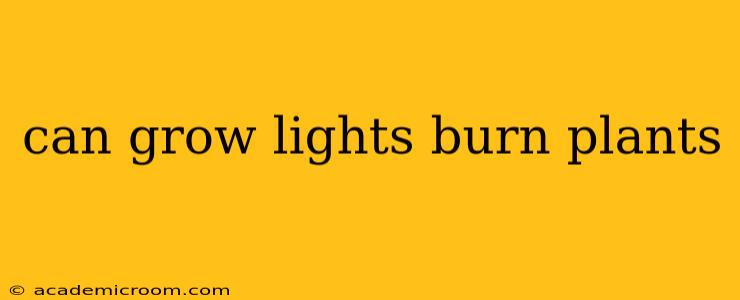Grow lights are essential tools for indoor gardening, providing the necessary light spectrum for healthy plant growth. However, a common concern among indoor gardeners is whether these lights can actually burn their plants. The short answer is: yes, they absolutely can, but it's usually due to misuse, not the lights themselves. This article will delve into the specifics, explaining how grow lights can damage plants and how to prevent it.
How Can Grow Lights Burn Plants?
The primary way grow lights burn plants is through heat stress. While the light itself is crucial for photosynthesis, many grow lights, particularly those with high wattage or insufficient ventilation, produce significant heat. This excessive heat can scorch leaves, leading to browning, wilting, and even death. The intensity and proximity of the light are key factors.
What are the signs of light burn on plants?
The symptoms of light burn are fairly distinct:
- Leaf discoloration: Look for bleached or lightened areas on the leaves, often starting at the tips or edges. This is a key indicator of light stress.
- Browning or crisping: Severe light burn can cause leaves to turn brown and crisp, almost as if they've been scorched.
- Wilting: Even before visible browning, you might notice your plants wilting more than usual. This indicates the plant is struggling to cope with the excessive heat.
- Leaf drop: As a last resort, the plant may drop its leaves to minimize the damage.
What types of grow lights are most likely to burn plants?
While all grow lights have the potential to cause heat stress, some are more prone to it than others:
- High-intensity discharge (HID) lights (HPS and MH): These lights are very powerful and produce significant heat. They require careful monitoring and proper ventilation.
- LED grow lights: Though generally cooler running than HID lights, even LEDs can burn plants if placed too close or if the wattage is too high for the size of your grow area.
- Fluorescent grow lights: These are usually the coolest running option, but even these can cause burn if they are incredibly close to the plants.
How close should grow lights be to plants?
The ideal distance between your grow lights and plants depends on several factors:
- Type of grow light: HID lights need significantly more distance than LEDs or fluorescents.
- Wattage of the light: Higher wattage lights need more distance.
- Stage of plant growth: Seedlings require less intense light and can be closer than mature plants.
A general rule of thumb is to start with a greater distance than you think you need and gradually reduce it as you observe your plants. You should be able to comfortably hold your hand between the light and the plants for several seconds without discomfort. If it's too hot for your hand, it's too hot for your plants.
How can I prevent my grow lights from burning my plants?
Here’s how to prevent grow light burn:
- Choose the right grow light for your needs: Consider the size of your grow space and the type of plants you're growing.
- Maintain proper distance: Start far away and gradually decrease the distance as needed, monitoring your plants closely.
- Ensure adequate ventilation: Good airflow around your plants will help dissipate heat. Use fans to circulate air.
- Monitor plant health regularly: Check your plants daily for signs of light stress. If you see any issues, adjust the light distance or intensity immediately.
- Use a light meter: A light meter will measure the actual light intensity at the canopy level, ensuring your plants receive the optimal amount of light.
What should I do if my plants are already showing signs of light burn?
If you notice signs of light burn, immediately:
- Increase the distance between the light and the plants.
- Improve ventilation: Add more fans to your grow area.
- Monitor closely: Continue to observe your plants for improvement. Severely damaged leaves might not recover, but new growth should be healthy if the issue is corrected promptly.
By understanding the potential for heat stress and taking preventive measures, you can successfully use grow lights to cultivate thriving indoor plants. Remember, prevention is always better than cure. Carefully monitoring your plants and adjusting your setup as needed are crucial for success.
